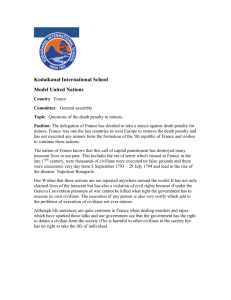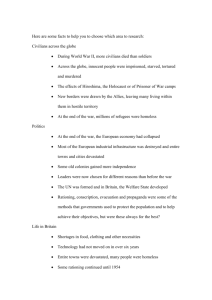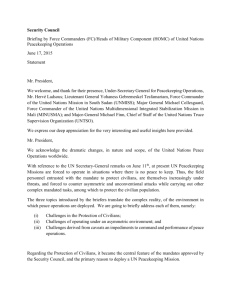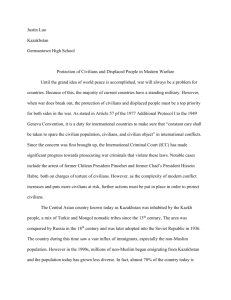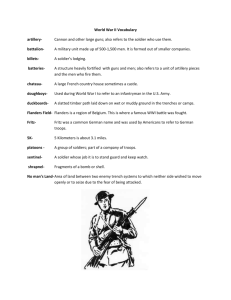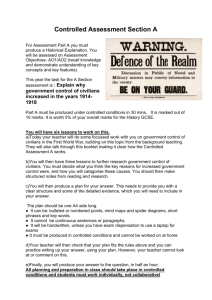Word - British Red Cross
advertisement
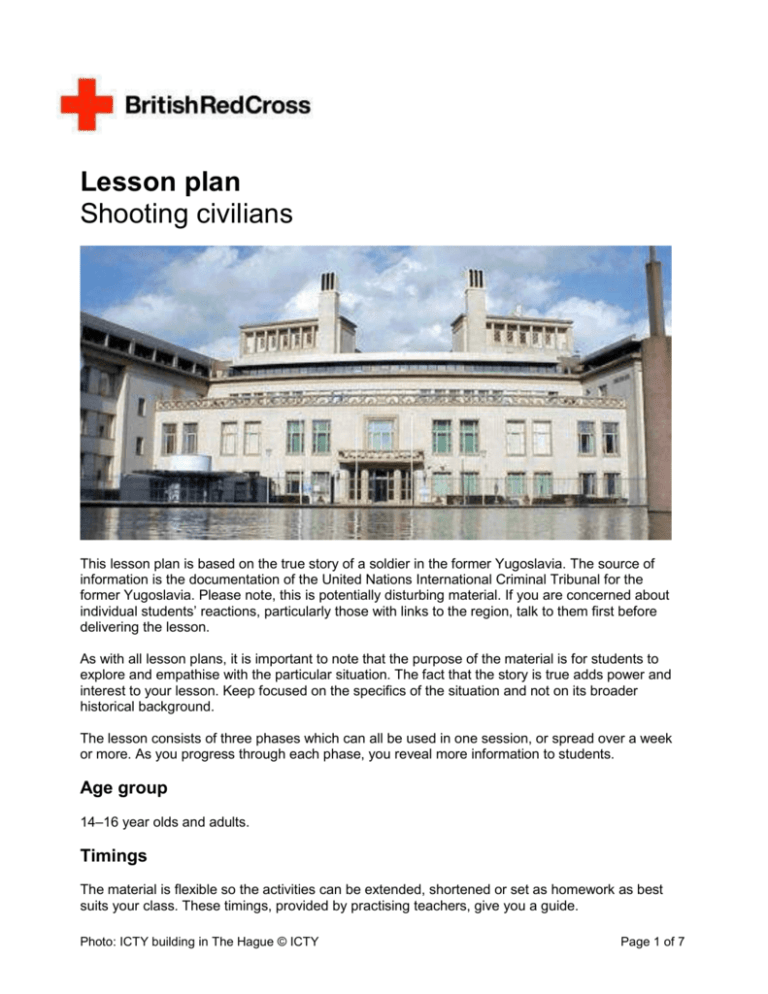
Lesson plan Shooting civilians This lesson plan is based on the true story of a soldier in the former Yugoslavia. The source of information is the documentation of the United Nations International Criminal Tribunal for the former Yugoslavia. Please note, this is potentially disturbing material. If you are concerned about individual students’ reactions, particularly those with links to the region, talk to them first before delivering the lesson. As with all lesson plans, it is important to note that the purpose of the material is for students to explore and empathise with the particular situation. The fact that the story is true adds power and interest to your lesson. Keep focused on the specifics of the situation and not on its broader historical background. The lesson consists of three phases which can all be used in one session, or spread over a week or more. As you progress through each phase, you reveal more information to students. Age group 14–16 year olds and adults. Timings The material is flexible so the activities can be extended, shortened or set as homework as best suits your class. These timings, provided by practising teachers, give you a guide. Photo: ICTY building in The Hague © ICTY Page 1 of 7 Lesson plan: Shooting civilians Phase 1 Phase 2 Phase 3 redcross.org.uk/education 1 hour 50 minutes 50 minutes Learning outcomes > Students will imagine themselves in a situation and explore their own feelings and those of characters involved. > Students will think about and express their feelings, both orally and in writing, about the situation. Page 2 of 7 Lesson plan: Shooting civilians redcross.org.uk/education Phase 1 Step A Explain to students that you want them to imagine themselves in this situation. Describe the situation to students. Imagine you are a man, aged 24. You have a wife and a nine-month-old son. You recently joined the army, partly because you fear being beaten up if you don’t, and partly because you need to support your wife and nine-month-old son. There is a civil war going on in your country. Various forces divided along religious, cultural or ethnic lines are fighting. One day you and your unit leave your base and drive deep into the countryside. You are told to wait on a deserted farm. You are nervous because you feel something is wrong. After a while, buses start arriving at the farm. You have been told to expect civilian men who have surrendered to the military or police to be arriving throughout the day. When the first bus arrives, men aged from 17 to 60 are led off in groups of ten. They are positioned next to a ditch with their back to you and the other soldiers. You are told to shoot them. Freeze the frame at this point. Ask students to express their reactions and have a brief discussion. What is your first reaction? How would you feel? What do you think might happen? Continue to describe the situation. You tell your commanding officer and colleagues that you do not want to take part in this. The officer replies that if that is what you think, you can just go and stand in the line together with the prisoners. “You can give us your rifle…” with the clear understanding that you will be shot by your fellow soldiers. Step B At this point, ask students ‘What would you do?’ Allow students to react to the situation, before moving on to the more focused activities below. Invite students to think and reflect on the feelings of those people involved in the situation in a focused way. You will decide whether to do this as an open class discussion, in small groups or as a written activity, depending on your group. Print the situation to hand out to students. First ask students to think of adjectives that might describe how the soldier felt when he heard the order. Try not to guide students too much, making suggestions only if necessary: afraid, sick, disgusted, confused, bewildered, revolted, helpless, panicky, etc. Ask students to think about the commanding officer. How did he feel when he gave the order? What pressures might he have been under? Now ask students to think about the soldier’s colleagues. Explain that some may have lost close family members in the conflict and blame the civilians they have been ordered to shoot. How might these soldiers be feeling? Would they feel differently from soldiers who hadn’t suffered a personal loss? Think about the civilians. What thoughts are going through their minds? Do they think their lives really are in danger or are they expecting just to be held captive somewhere? Do their families know what is going to happen to them? Page 3 of 7 Lesson plan: Shooting civilians redcross.org.uk/education Step C Using the thoughts and notes from the discussion, ask students to prepare one of two dialogues, being as realistic as possible. Ask students to imagine the conversation that might have taken place, the feelings expressed and the language and tone used. > A conversation between the commanding officer and the soldier refusing to carry out the order. > A conversation between the soldier and one of his colleagues. Page 4 of 7 Lesson plan: Shooting civilians redcross.org.uk/education Phase 2 Step A At this point, either as part of the same lesson or at a later date, tell students that the situation is not a fictional one dreamed up to get people talking. It happened exactly as described to a 24 year old called Dražen Erdemović (pronounced Drazhen Erdemovitch) during the fighting in the former Yugoslavia. On 16 July 1995, Dražen Erdemović and other members of the 10th Sabotage Detachment of the Bosnian Serb army were ordered to a collective farm near Pilica. Erdemović and other members of his unit were informed that bus loads of Bosnian Muslim civilian men from Srebrenica, who had surrendered to Bosnian Serb military or police personnel, would be arriving throughout the day at this collective farm. Each bus was full of men, ranging from approximately 17 to 60 years of age. After each bus arrived at the farm, the men were removed in groups of about 10, escorted by members of the 10th Sabotage Detachment to a field adjacent to farm buildings and lined up in a row with their backs facing Erdemović and members of his unit. Dražen Erdemović and other members of his unit and soldiers from another brigade shot and killed the unarmed men. These summary executions resulted in the deaths of hundreds of Bosnian Muslim male civilians. Step B Explain to students that this information comes from the charges laid out at his trial. You can then give them more details about his trial. Dražen Erdemović’s trial took place at an International Criminal Tribunal held in the Netherlands city of the Hague. The tribunal was set up to prosecute those responsible for serious violations of international humanitarian law committed in the territory of the former Yugoslavia. The main rules of this law, also called the laws of war, are contained in the Geneva Conventions, and serious violations of these rules are called war crimes. At his trial, Erdemović pleaded guilty to the war crime of murder of civilians. He also told the court, “Your Honour, I had to do this. If I had refused, I would have been killed together with the victims. When I refused, they told me: ‘If you are sorry for them, stand up, line up with them and we will kill you too’. I am not sorry for myself but for my family my wife and son who then had nine months [i.e. was nine months old], and I could not refuse because they would have killed me.” Step C Before telling the class what sentence the tribunal passed, invite students to say what sentence they would pass and why. Tell them that the maximum sentence for crimes against humanity or war crimes including murder is life imprisonment. Summarise for students: The defendant has pleaded guilty to murder of civilians and the families and memories of the murdered people demand justice. But he has also said he would have been killed if he refused to obey orders. This activity could be carried out as a class discussion or as a piece of writing. Page 5 of 7 Lesson plan: Shooting civilians redcross.org.uk/education Phase 3 Step A You can now tell students what happened. The judge in the original trial sentenced Dražen Erdemović to ten years’ imprisonment. An appeal judge reduced that time to five years. He served his time and is now free. Bearing in mind the discussions from phase 2, ask students whether they think the sentence was too light, too severe or about right. Get a show of hands. Step B Next, point out these aspects of international law to help them. Print this section to give to students. According to international law, duress – that is being forced to do something – cannot amount to a complete defence to a soldier charged with a crime against humanity or a war crime involving the killing of innocent human beings. There are some orders that a soldier has a duty to disobey because they are serious violations of the Geneva Conventions or the laws and customs of war. However, it may be taken into account ‘in mitigation’ – that is, in looking at the whole situation and deciding whether there is a reason to impose a reduced sentence. In deciding these mitigating factors, in Dražen Erdemović’s case, the tribunal looked at: a His age. He was young enough to reform, and to start life afresh after his sentence. b His background. He was from a multi-ethnic background, with no sense of nationalism and a dislike of war. c His character and behaviour. He confessed and consistently admitted his guilt. He came forward voluntarily and told of his part in the massacres before his involvement was known to any investigating authorities. He was regarded as honest. He was full of remorse. d He cooperated with the trial and the investigation. His testimony helped provide details of this and other war crimes and helped in the evidence against other defendants. e He committed the crimes under duress. The tribunal found there was a real risk that the accused would have been killed had he disobeyed the order. He voiced his feelings, but realised that he had no choice in the matter: he had to kill or be killed. Invite students to discuss these mitigating factors and consider them against the suffering of the victims and their families and the need for justice. If students had the role of sentencing judge, what weight would they give each of these? Ask students to put the factors in order of importance in their opinion. Step C Now tell students that they will have to argue their case for a more severe or a lighter sentence. To give them an extra challenge, you could ask them to argue for a position different from the one they really hold. Using the information they have acquired about the case in all three phases, they can either prepare an oral piece or a written piece. Page 6 of 7 Lesson plan: Shooting civilians redcross.org.uk/education Optional extension Writing activity The tribunal heard that there were two survivors from the massacre at Pilica farm on 16 July 1995. They were lined up in front of the execution squad and fired at. But they survived. They lay among the bodies for the rest of the afternoon. After sunset they crawled to freedom and were picked up by a patrol, taken to a nearby town and put into a prisoner camp. They were registered there by the Red Cross and later released as part of a prisoner exchange. Set students a piece of creative writing in which they imagine that they were one of the prisoners who survived the execution. Suggest focusing on their current thoughts and feelings – about war, about their lost colleagues, about their attitude to their own survival – as well as their feelings on the day the events occurred. Notes The central character in this account, Dražen Erdemović, is a Bosnian with a Croatian mother and Serbian father. He was working with a unit of the Bosnian Serb army. But, confusingly, he had also served in the opposing army, the Croatian Defence Council, known as the HVO. Those executed were Bosnian Muslims. This detail is provided because it is true, but the point is to illustrate something about the nature of wars and conflicts anywhere. Do not encourage conclusions to be drawn about the nature of any ethnic group or the relative behaviour of any army. This example does not permit any such generalisations, and the British Red Cross, like the whole of the worldwide Red Cross and Red Crescent movement, is committed to relieving suffering and reducing death wherever and however it happens. In all its work it acts neutrally and impartially. This lesson plan was researched and written by PJ White and produced in March 2006 and revised in November 2009. For more information contact: Schools and community education British Red Cross 44 Moorfields London EC2Y 9AL Email: reducation@redcross.org.uk This resource and other free educational materials are available at redcross.org.uk/education. Page 7 of 7

